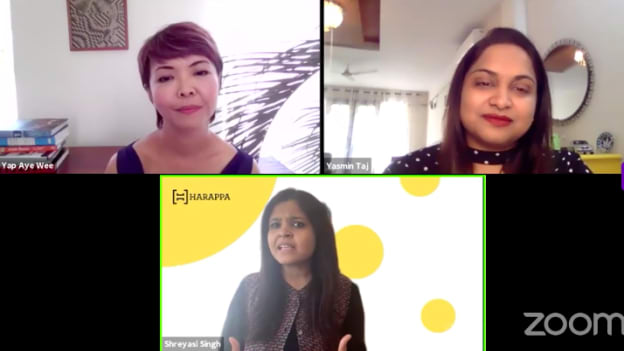Nurturing a learning organization: A fireside chat

We all know that it is not enough to simply survive in an increasingly complex and constantly changing world. One must thrive and gain from complexity and disorder. One must be antifragile. One must be a learning organization. But what exactly is a learning organization? How can one go about building it? What are some design principles?
In a recent session at People Matters L&D SEA Conference 2021, Aye Wee Yap, SVP, Head of L&D and OD, Group Human Resources at OCBC Bank and Shreyasi Singh, Founder & CEO, Harappa Education decoded what it takes to build an effective learning organization. According to them, building a learning organization is not at all an easy task—one needs to get a 360 degree perspective of learners, line managers, and leaders to pave the way for a learning culture.
Here is an excerpt from the fireside chat where Yasmin Taj, Managing Editor at People Matters put forward some challenging questions to Aye Wee Yap and Shreyasi Singh, on building an effective learning organization where people learn continuously and unpromptedly. Learn about what has worked for their organizations and what hasn’t, and be inspired in equal measures by their successes and failures.
Q1. How has the definition of a learning organization changed from the times of Peter Sange who popularized the concept of a learning organization, and why has it become even more critical than ever?
Aye Wee Yap: Fundamentally, I think the concept of a learning organization has not changed. When we look at Senge’s definition, the Learning Organization (LO) is defined as one where people are learning continually on how to learn together. Although Senge advocates five technologies to building a LO, I personally find that operationally actualizing the LO is not so easy. I mean, conceptually, we get the idea of how to build a LO but how do we get it done? How do you make it happen? In my experience with my team, we need to look at the specific context of the organization and discern for ourselves a set of unique design principles that would work for that organization.
I think having an aspirational learning organization would be where learning is unprompted and continuous.
Shreyasi: We have to make learning intuitive and fun and unprompted but only if it's an enjoyable experience. I think, as human beings, we reject what we don't enjoy doing, and given how much we need to learn about how many things, we can't afford to have learning programs that people do not enjoy. Organizations have to make the experience fun and I think many learning organizations or aspiring learning organizations are acknowledging and are working towards it.
Q2. What are some design principles which an organization needs to look at while building a learning organization?
Aye Wee Yap: Let me share a little bit about what my team has been experimenting with for the last five to six years in the OCBC Group. We've got some very interesting findings:
- First and foremost, I think it's very important for us to understand that each organization is unique, and our cultures are too different so we need to find what works for that culture.
- There are two dimensions that we have to address in order to nurture a learning organization – accessibility of learning courses and second, motivation to learn or complete these learning courses.
- There are three principles to get people to motivate: the principle of autonomy, the principle of competence or mastery, and the third is the principle of relatedness.
We have been experimenting with a few programs, and in the financial services industry, you know we have a lot of compulsory programs or regulatory in nature. However, we wanted people to like to learn rather than being dragged to complete the eLearning courses. So then the question was, how do you make something mandatory appear autonomous? We solved this challenge by injecting optionality into our learning design. We conducted a quiz of 20 questions, and our agreement with a trainee or the learner was to take this quiz up front. If you pass it and you get a 100% score, you have got a choice to take the rest of the program, or well, because you aced it, you can choose not to do the program.
I feel if we intentionally find ways to be creative and inject autonomy or a sense of choice in the programs, learning will be a pull factor than a push factor.
Shreyasi: As the founder and CEO of an online learning institution, I keep saying that the real innovation is not in data but in cracking learners’ motivation. We need to design a learning journey even before a learner enrolls herself/himself in a learning program.
For example, can you create a video version of the learning program, or can you create an audio version of it, or can you create a text version? I think the opportunity we have right now, especially in an online format, is creating experiences for our learners through a multi-channel format and giving them autonomy to select the format they feel most easier to assimilate.
Even if people can't always choose what they want to learn they can atleast choose the way they want to learn and I think that’s the kind of innovation that we require.
Q4. What concrete changes in behavior are required in building a learning organization?
Shreyasi: For me, the first behavior change is the fact that I think leaders need to acknowledge that it's only when people visibly and tangibly see leaders having learned something, not necessarily at work, they would follow you and get motivated to learn. So, I think, all learning leaders and people custodians—whether CXOs, HR Heads, or learning heads—have to first and foremost feel genuine about being learning ambassadors.
The second behavioral shift is setting mini-milestones. You don’t need to achieve massive learning goals every month but set up an incremental journey of learning for 10 minutes a day. It is just like fiscal personal finance– You put away a little bit every month, 10 minutes a day. Hence, I think the biggest behavior change in learning would be to get leaders to be role models. Also, we must break the learning program into a small incremental activity that makes it possible for everyone to do everything.
Aye Wee Yap: I agree with Shreyasi. I think the behaviors of line managers are very critical. We can initiate numerous learning programs, but many a time, a line manager will come and pull out an employee from a learning program due to some “urgent” events and such behaviors diminishes the gravitas of learning.
We need to have an onboarding for managers and ask them how they can support a learning program and what support they would need when this learning program would be running.
Q5. And how do managers come to know they have become a learning organization? How do you measure the progress and effectiveness of efforts?
Shreyasi: There are many ways to measure effectiveness but for me, it would be these four things – enrollment much before the deadline, oversubscription of the learning program, completion of the learning program well within deadlines (aspirationally unprompted but even if it is prompted, it still leads to completion), and learner feedback and observed feedback.
Aye Wee Yap: A typical way of measuring is to assess behaviors. So, a lot of our assessment tools are moving towards behavioral assessments. Further, I would say that it takes a village. I mean it's not just the learner in the organization but the team and the leaders. So when we take behavioral health checks, we make an effort to look at it from a 360-degree perspective. So we're not just measuring the learner, because we do know that organizations can have motivated learners, but it's everything else that is preventing the learner from stepping forward, and vice versa.















